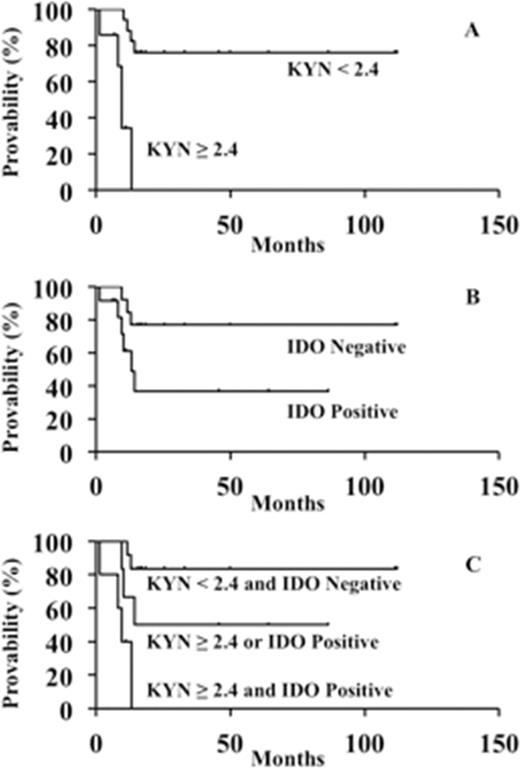Abstract
Introduction: The intracellular enzyme indoleamine 2,3-dioxygenase (IDO) catalyzes the initial and rate-limiting step in the metabolism of the essential amino acid tryptophan along the L-kynurenine (KYN) pathway. Some metabolites derived from tryptophan via IDO catalysis such as KYN block antigen-driven specific T-cell proliferation and induce T-cell death. IDO activity might play an important role in regulating the immune response exerted by antigen presenting cells. Indeed, we have recently reported the utility of either serum KYN or the expression of IDO mRNA as prognostic factors for acute myeloid leukemia (AML) [Leuk Lymphoma: In press, Leuk Lymphoma 56:1398-405]. Here, we investigated the value of combination of serum KYN level and expression of IDO mRNA as a prognostic factor in AML patients.
Patients and Methods: AML was diagnosed according to the WHO 2008 criteria based on standard cytological and histochemical assessments of smears of cryopreserved bone marrow cells from 29 consecutive adult patients between December 2005 and March 2014. All patients in this study had been enrolled in both our serum KYN study and expression of IDO mRNA study. All follow-up data were fixed on August 1, 2014. KYN concentrations in serum samples were measured by high-performance liquid chromatography. Bone marrow-derived mononuclear fractions were separated and IDO expression was analyzed by using extracted mRNA amplified by PCR.
Results: We examined expression of IDO mRNA and serum L-kynurenine in a total of 29 patients (median age, 55 years; range, 18-74 years). Among them, 11, 14 and 4 patients were classified as having favorable, intermediate and unfavorable cytogenetic risk, respectively. Twenty seven patients underwent standard intensive chemotherapy, mainly consisting of cytosine arabinoside (Ara-C) and anthracycline. All patients with acute promyelocytic leukemia (n = 5) received induction therapy containing all-trans retinoic acid. Two patients received less intensive chemotherapy [J Cancer Res Clin Oncol. 133:547-53.], because of poor performance status. The median serum KYN level was 1.63 µM (range, 0.66-5.27 µM). We set the L-kynurenine cut-off value at 2.4 µM according to our previous report. The RT-PCR results showed that bone marrow from 12 (41%) patients were IDO-positive. No significant correlation was identified between serum KYN level and IDO expression. Complete remission (CR) rates were 57% and 86% for patients with KYN levels ≥2.4 and <2.4 µM, respectively. CR with initial therapy was obtained by 67% of patients with positive IDO expression, compared to 88% with negative IDO expression, respectively. Three-year OS rates were 0% and 76% for patients with KYN ≥2.4 and <2.4 µM, respectively (P<0.0001), and 37% and 77% for patients with IDO-positive and IDO-negative AML, respectively (P=0.0511) (Figs. 1A, B). Three-year OS rates were 83%, 50% and 0% for patients with low KYN and IDO-negative, either high KYN or IDO-positive, and high KYN and IDO-positive, respectively (P < 0.005; Fig. 1C.).
Discussion: In the present study, we assessed the significance of serum concentration of KYN, IDO mRNA expression, and the combination of these two factors in AML patients and demonstrated their prognostic value. High serum KYN concentration was associated with poor outcomes of AML. While, expression of IDO mRNA had a tendency with poor prognosis, it did not show significant difference on the survival of AML patients. These results were due to the small sample size in this study, and will have to be confirmed in future studies with larger numbers of patients.When we compare these two factors as prognostic value, serum concentration of KYN may be more useful because measurement of serum concentration of KYN is easier than IDO mRNA expression and identifies ultra-high risk patients. In contrast, serum concentration of KYN has poor separation capacity for many other patient, which can be further subdivided by adding measurement of IDO mRNA expression. Indeed, the combination of serum concentration of KYN and IDO mRNA expression was associated with poor outcomes of AML and was able to subdivide the AML patients to three different prognostic groups clearly.
Conclusion: This study clearly showed the prognostic value of the combination of serum KYN concentration and IDOm RNA expression for AML patients.
Overall survival according to serum L-kynurenine concentration and IDO expression.
Overall survival according to serum L-kynurenine concentration and IDO expression.
No relevant conflicts of interest to declare.
Author notes
Asterisk with author names denotes non-ASH members.


This feature is available to Subscribers Only
Sign In or Create an Account Close Modal